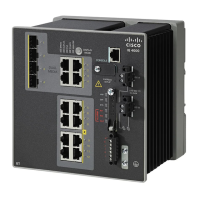99
— 9600 baud
— 8 data bits
— 1 stop bit
— No parity
— None (flow control)
7. Connect power to the switch as described in Connecting to Power, page 37.
The PC or terminal displays the bootloader sequence.
8. Press Enter to display the setup prompt.
9. Follow the steps in the Completing the Setup Program, page 100.
Installing the Cisco Microsoft Windows XP, 2000, Vista, 7, 8, and 10 USB Device
Driver
A USB device driver must be installed the first time a Microsoft Windows-based PC is connected to the USB console
port on the switch. Use this procedure to install the USB driver on Windows XP, Windows 2000, Windows Vista,
Windows 7, Windows 8, and Windows 10.
1. Obtain the file Cisco_usbconsole_driver_3_1.zip from the Cisco.com website
https://software.cisco.com/download/release.html?mdfid=282979369&softwareid=282855122&release=3.1
The file details are as follows:
— Description: Cisco_usbconsole_driver_3_1.zip
— Release: 3.1
— Release Date: 27/Nov/2014
— File Name: Cisco_usbconsole_driver_3_1.zip
— Size: 14.35 MB (15045453 bytes)
— MD5 Checksum: eff2e955edcdc70209e6f9c8f6bd59cd
2. Unzip the file and install the corresponding exe file.
3. Navigate to the Device Manager window by performing a search in WIndows for Device Manager and opening it.
4. Connect the USB cable from the Windows PC to the Cisco switch.
5. From the Device Manager page, expand Ports (COM & LPT). Select USB Serial Port. Right-click and select Update
Driver Software ...
6. In the Update Driver Software window, select Browse my computer for driver software. Then choose Let me pick
from a list of device drivers on my computer and click Next.
7. Enable Show compatible hardware and choose Cisco Serial as the model. Click Next.
After the update is completed, Windows displays Windows has successfully updated your driver software.
8. Click Close.

